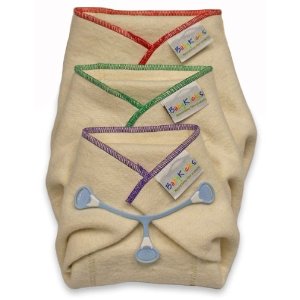Cloth nappies are as much an option for parents today as they were hundreds of years ago. They remain popular for their economical, comfortable, and eco-friendly features. Commonly found in local stores and online, there are various quality options and sizes available for the growing baby. Options on the market include flat diapers, prefold cloth diapers, and fitted cloth diapers.
Flat nappies are single-layered and available in cotton gauze material. Prefold cloth nappies have multiple layers, with additional layering in the center to provide extra absorption where most needed. Fitted cloth nappies are elastic at the leg and closely resemble disposables, and come with either snap or Velcro fasteners.
Both prefolds and fitted diapers are produced with cotton, hemp or bamboo fabrics and come bleached or unbleached. Unbleached Chinese prefolds are high quality with superior absorption properties. Bamboo nappies are made with rayon material produced from bamboo plants. Unique and generally considered to be eco-friendly, they are 70% more absorbent than cotton and dry quickly.
Cloth nappies are used together with covers that serve as a wetness barrier. Covers come in a pull-on design or with snap or Velcro side fasteners, and are available in assorted fashion designs and materials including polyurethane laminate (PUL), nylon, polyester fleece, and wool. PUL covers are made with a quality polyester fabric that is thinly coated with waterproof application. Providing exceptional wetness protection, PUL fabric covers are among the favored diaper covers used today.
Prefold Diaper Folding Instructions

Newspaper Fold: This fold provides multiple front layers for wetness absorption, making it particularly effective for baby boys. Slightly bulkier than other options, it is best suited for babies with thin to average thighs.
Beginning with the flat diaper, place the baby so that the back edge of the diaper approximately at navel level.
Fold the front edge up so that it will comfortably fit just below the navel. The size of this fold will depend on diaper and baby size.
Beginning on one side of the diaper, fold over an edge until it meets at the center of the diaper. Do the same on the other side and tuck that edge into the space, or pocket, formed by the first side fold.
Then pull the diaper up between the thighs and secure to the back wings of the diaper.
If pins are used, pull up one back corner at a time, lay it over the front section and attach. Pins must go through at slightly below the top section to ensure a secure fit. If using a snappi device, hold both back corners over the diaper front and hooking one side at a time, before attaching the third hook at the center of the front section of the diaper.
Angel Wing Fold: Place the baby as with the Newspaper fold.
Fold the front sides into thirds, overlapping one side equally over the other.
Bring the front of the diaper up between the thighs, tucking the front edge under until the folded edge is just below navel level. Bring the back corners over the front of the diaper and secure with pins or a snappi.
This fold will form a gusset at the thigh for extra protection.
Bikini Twist Fold: The Bikini Twist fold is simple and quickly donned. It is fairly streamlined and well-suited for babies with thicker thighs and, in particular, for baby girls because of the extra thickness provided in the twisted area. Lauded for its ability to contain messy bowel movements, some users contend that the twisted section can make clean up more challenging.
First situate the baby as with the Newspaper fold.
Next, twist the front half of the diaper by bringing each corner of the diaper to the opposite side (basically a 180 degree flip).
Bring the front of the diaper up between the thighs and fold down the front edge until the folded edge is slightly below the navel.
Finally, bring both back corners over the diaper front and fasten each side with pins or a snappi.
Sidewall/Jellyroll Fold: Begin by placing baby as with the Newspaper fold.
Roll the side edges of the diaper at a slight angle so that the edges are tapered taper towards the front edge.
Bring the front edge up between the thighs and tuck under the front edge so that it lies below the navel.
Bring the back corners over the front of the diaper and secure with pins or a snappi.
Choosing a modern cloth diaper, be it a prefold, pocket, fitted cloth diaper or all-in-one is a wise, eco-conscious and frugal decision. With the variety of diaper and cover types and materials from which to choose, it can be an exciting venture at too. Whether deciding to use one or more nappy styles together with PUL fabric covers, the outcome will be exemplary.



